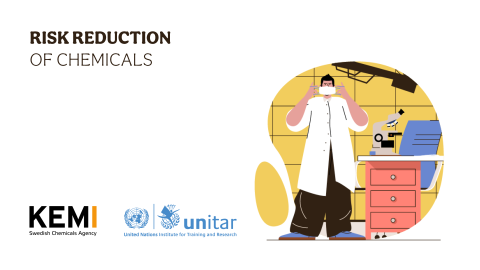
Risk Reduction of Chemicals
After taking the course, participants will be able to:
- Explain the key steps in the risk reduction process
- Describe and compare the different roles and responsibilities of government and industry in the risk reduction process
- Explain the importance of providing accurate information regarding hazards and exposure
- Identify different instruments that can be used as risk reduction measures for different contexts
This course is based on the Swedish Chemical Agency’s - KemI - publication on “Risk Reduction of Chemicals”, one of a series of documents developed by the Swedish Chemicals Agency, is a complement to the UNEP Guidance on the Development of Legal and Institutional Infrastructures and Measures for Recovering Costs of National Administration (LIRA guidance). It supplements the LIRA guidance with further guidance related to risk reduction measures with regard to the control of chemicals placed on the market.
The aim of this course is to give guidance to countries (governments and authorities) in their efforts to set up an efficient system for the sound management of chemicals with a special focus on legal and voluntary tools for risk reduction of chemical substances, on their own or when used in mixtures or in articles. The course focuses on preventive chemicals control; measures directed towards the placing of chemicals on the market. The risk management of chemicals covered here makes use of information on the properties of chemicals at an early point in their life cycle, helping to manage exposure to chemicals with adverse effects.
Module 1 - Risk, risk reduction and risk prevention
Content
1. The basics of risk reduction
2. Roles and responsibilities of government and industry
3. Legislation as a foundation for risk reduction
4. Dissemination of information along the supply chain
Module 2 - The role of risk assessment
Content
1. How is risk assessed?
2. Role of the authorities in risk assessment
3. Role of industry in risk assessment
Module 3 - Priority setting (prioritising chemicals for risk management)
Content
1. What substances should be prioritised?
2. Sources of information supporting prioritisation
Module 4 - Risk reduction instruments
Content
1. How to choose the most appropriate risk reduction instrument
2. Administrative instruments
3. Economic policy instruments
4. Informative instruments (and general information)
5. Implementation of international conventions
The course, about 45 minutes to complete, is self-paced and adapted to the schedule of full-time working professionals. Participants are provided with the opportunity to learn through various experiences: absorb (read); interact (activity); and reflect (relate to one’s own reality). This includes videos, interactive lessons, reading materials and quizzes.
Despite being self-standing, the 4 modules of the course must be completed in order.
Each module concludes with a quiz which will assess the knowledge learners will acquire. If learners pass the quiz with a 100% mark, a certificate of completion will be issued to them.
Participants will be requested to provide feedback on the course by filling in a feedback form after completing all the modules, accessible anytime.
This course is targeted at national chemicals officials but is intended to be of interest to a broad range of sectors and stakeholders involved in chemicals management at the national level (e.g. agriculture, environment, health, labour, trade and industry, transport).
It may be of particular relevance to those directly involved in undertaking and/or evaluating risk assessments or involved in any steps of the risk
The course can be completed on any computer (Windows and Mac) or mobile device. Any internet browser is compatible as long as it has been updated to its latest version.

